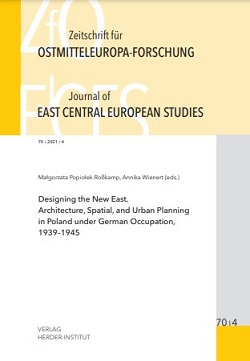Heim and Heimat — Poznań during the Second World War as a Starting Point for Possible Paths of Interpretation
Heim and Heimat — Poznań during the Second World War as a Starting Point for Possible Paths of Interpretation
Author(s): Hanna Grzeszczuk-BrendelSubject(s): Architecture, History of ideas, Studies in violence and power, Policy, planning, forecast and speculation, Victimology, WW II and following years (1940 - 1949), Social Norms / Social Control
Published by: Verlag Herder-Institut
Keywords: Poznań; architecture; Second World War; housing; furniture;
Summary/Abstract: The building construction and design activity in Poznań, which was annexed to the Third Reich during the Second World War as the capital of Gau Wartheland, largely encompassed residential and landscape architecture. This begs the question about the ideological significance of the private space created for the Germans settling in the region of Greater Poland. The starting point for the discussion of this issue are the terms Heim and Heimat, which highlight the interwoven relationship of home and the surrounding spaces. The consideration of these terms provides the basis for analyzing the forms and scale of residential construction and how it was related to transformed landscape of Poznań, as well as for reflecting on how apartment layouts and their typical furnishings defined the roles and places of women and men within the system. The titular relationship between Heim and Heimat introduces the problem of the landscape and everyday lives of “ordinary” Germans serving the regime into the sphere of architectural studies and leads to the conclusion that ideology influenced everyday architecture just as much as official spaces. It also shows that the concept of Neugestaltung (redesigning) pertained both to urban planning and landscape, which together were intended to create a model landscape on the occupied lands. Scholars in search of answers to the questions outlined here would be well advised to consider various interpretative tropes that might enable a more comprehensive understanding of the relationships between architecture, landscape, and ideology.
Journal: Zeitschrift für Ostmitteleuropa-Forschung
- Issue Year: 70/2021
- Issue No: 4
- Page Range: 609-627
- Page Count: 19
- Language: English

